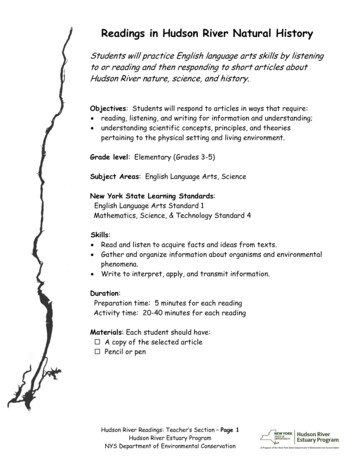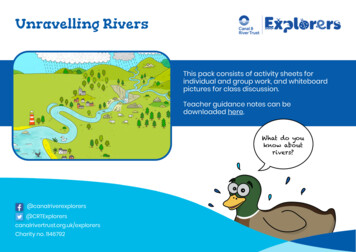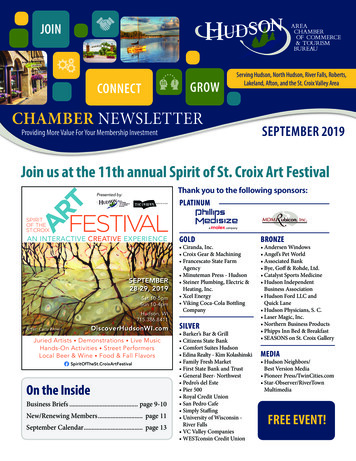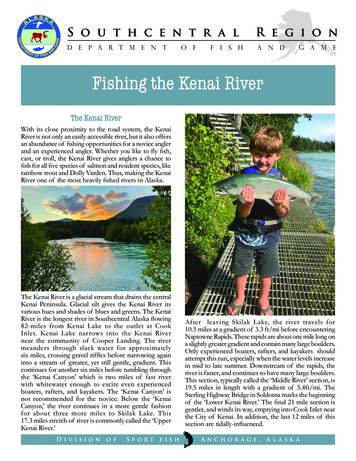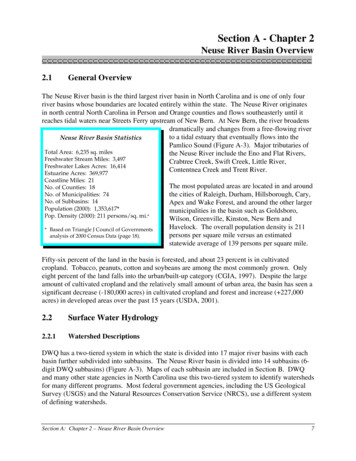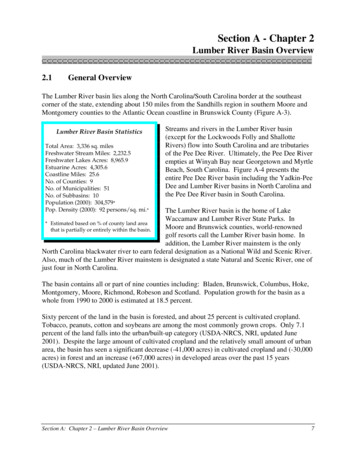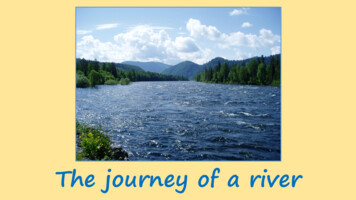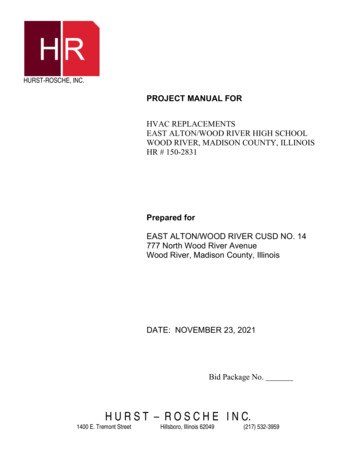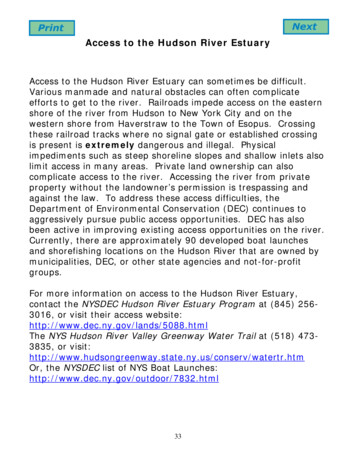
Transcription
Access to the Hudson River EstuaryAccess to the Hudson River Estuary can sometimes be difficult.Various manmade and natural obstacles can often complicateefforts to get to the river. Railroads impede access on the easternshore of the river from Hudson to New York City and on thewestern shore from Haverstraw to the Town of Esopus. Crossingthese railroad tracks where no signal gate or established crossingis present is extremely dangerous and illegal. Physicalimpediments such as steep shoreline slopes and shallow inlets alsolimit access in many areas. Private land ownership can alsocomplicate access to the river. Accessing the river from privateproperty without the landowner’s permission is trespassing andagainst the law. To address these access difficulties, theDepartment of Environmental Conservation (DEC) continues toaggressively pursue public access opportunities. DEC has alsobeen active in improving existing access opportunities on the river.Currently, there are approximately 90 developed boat launchesand shorefishing locations on the Hudson River that are owned bymunicipalities, DEC, or other state agencies and not-for-profitgroups.For more information on access to the Hudson River Estuary,contact the NYSDEC Hudson River Estuary Program at (845) 2563016, or visit their access website:http://www.dec.ny.gov/lands/5088.htmlThe NYS Hudson River Valley Greenway Water Trail at (518) 4733835, or v/watertr.htmOr, the NYSDEC list of NYS Boat Launches:http://www.dec.ny.gov/outdoor/7832.html33
Boating and Water SafetyThe Hudson is a big river subject to rough weather conditions, strongcurrents, and heavy commercial and recreational boat use. Barges andother large commercial vessels are common on the river. Wakes fromthese vessels, including secondary wakes caused by the initial wakebouncing off the shoreline, can be dangerous to small vessels. The Hudsonis a tidal river, with water depths changing markedly from high (flood) tolow (ebb) tide. This can significantly impact where you can navigate onthe river. Boaters on the Hudson must be familiar with the rules andregulations associated with boating on a large navigable waterway such asthe Hudson. Boaters should also be sure to carry the appropriate safetyequipment for the boat they are operating. One of the most importantsafety items is a life vest (or personal floatation device (PFD)). Childrenunder the age of 12 must wear a U.S. Coast Guard approved Type 1, 2 or3 PFD when underway. Every pleasure boat, including kayaks, canoes androwboats, must have on board at least one wearable U.S. Coast Guardapproved PFD for every person on board. The PFD must be in goodcondition and readily accessible. Vessels 16 ft. in length and larger mustalso carry a U.S. Coast Guard approved throwable flotation device. Inaddition to PFDs numerous other safety items must be carried on board aboat. Required equipment varies depending upon the size of your boat.The operator or person in control of the vessel is responsible forcompliance with all safety regulations.For a complete reference of required equipment and the rules andregulations associated with safe boating in New York State, contact theNew York State Office of Parks, Recreation and Historic Preservation at(518) 474-0445, or download a copy of the New York State Boaters Guideat: www.nysparks.com/boating/resource.aspAdditional information can also be found at the United States Coast Guardwebsite: www.uscgboating.orgAnglers and boaters planning on using the Erie or Champlain Canals, whichallow Hudson boaters to access Lake Champlain and the Great Lakes,should contact the New York State Canal Corporation at (518) 471-5011,or visit their website at: www.nyscanals.gov34
Fishing RegulationsA freshwater fishing license is not required when fishing the waters of theHudson River south of the Troy Barrier Dam. A fishing license is requiredto fish the entire length of all tributaries of the Hudson south of the TroyDam to the Tappan Zee Bridge even if the tributary is subject to tidalflow. Regulations associated with the take of freshwater fish speciesfrom the Hudson River can be found in the New York State FreshwaterFishing Regulations Guide available at all DEC regional offices, licensesales outlets, or by calling (518) 402-8920. Regulations can also befound on the DEC website at: www.dec.ny.gov/outdoor/7917.htmlFor marine fishing regulations call (631) 444-0435 or go to the Division ofMarine Resources Saltwater Regulations webpage at:www.dec.ny.gov/outdoor/7894.htmlCircle Hooks: Scientific research indicates that the use of circle hooksreduces mortality on fish that are caught and released. New regulationson the Hudson are proposed that, if passed, will take effect in 2007.Under these regulations, the use of circle hooks will be required if you arefishing in the Hudson using natural bait (minnows, worms, dough balls,etc.) between April 15 and June 1.35
Hudson River Fish Consumption AdvisoriesThe Hudson River Estuary has a very large watershed that includes manyurban areas, factory towns, and other sources of pollution.Unfortunately, this has resulted in the addition of chemicals, pathogensand heavy metals to the river that have found their way into the bodies ofsome Hudson fish species. As a result, fish consumption advisories havebeen established by the New York State Department of Health (NYSDOH)for many Hudson River fish species. Fish consumption advisories areupdated annually and can be found in the New York State FishingRegulations Guide or by visiting the NYSDOH website ish/fish.htmFor more information on health effects associated with exposure tochemical contaminants call NYSDOH at 1-800-458-1158 x 27815.36
Hudson River Fish Species of Interest to AnglersPopular GamefishMore info:www.dec.ny.gov/animals/269.htmlStriped Bass, or Stripers, easily distinguished bythe seven to nine dark horizontal lines found alongtheir sides, vary considerably in size, ranging from18 to 55 inches in length and three to 70 pounds inweight. On the Hudson River, striped bass fishing isbest during the spring spawning run from March toJune.American Shad, the largest of the herring in theHudson, average 20 to 23 inches in length and five tosix pounds in weight. During spawning, April toJune, shad arrive in large schools, running up therivers where they slowly adjust to the change fromsalt to fresh water.Smallmouth Bass, members of the sunfish family,are famous for their fighting ability when hooked andhave the reputation for being, inch-for-inch, the bestsporting fish around. Adult smallmouth bass areusually found near the protection of rocks or nearsubmerged logs. Early morning and evening aretheir most active feeding times.Largemouth Bass, also of the sunfish family, havebeen known to reach weights in excess of tenpounds. They are rather solitary fish, preferring tostay among dense aquatic vegetation or close tosubmerged cover, such as stumps, logs, or dockpilings.Excerpts from articles in The Conservationist magazine, authored by Eileen C. Stegemann & Douglas Stang37
Hudson River Fish Species of Interest to AnglersWhite Perch, NY’s smallest true bass, seldom reachmore than 12 inches in length. Like striped bass,white perch can live in both fresh and saltwater.They often occur in large schools in turbid shallowareas. White perch are especially easy to catch inthe spring during spawning. Although small in size,they can put up a good fight when hooked.Yellow Perch, ranging in length from six to 12inches, prefer shallow, weedy protected sections.Yellow perch spawn in April or May and are mostactive in the morning and evening. They eat a varietyof organisms, including aquatic insects, crayfish, andfish.Channel Catfish, the largest of New York State'scatfish, can reach trophy size of 20-plus pounds.Channel catfish are most active just before sunriseand sunset. Catfish have a very diverse diet,generally eating any object they can get their mouthsaround.White Catfish are found throughout the HudsonRiver. Adults are almost always medium-sized,averaging eight to 14 inches in length. Catfish arenocturnal - feeding most actively at night.Blue Crab, one of the largest crustaceans, has fivepairs of legs. The first pair are claws, and the lastpair are adapted into swimming paddles. Adults willeat mollusks and bivalves, using their claws tomanipulate them. Other food items include dead orlive fish, blue crabs, shrimp, organic debris, andaquatic plants.Excerpts from articles in The Conservationist magazine, authored by Eileen C. Stegemann & Douglas Stang38
Hudson River Fish Species of Interest to AnglersCarp, first introduced into New York State waters in1831, can grow quite large, more than 40 pounds!They eat a variety of plant and animal material andare often spotted by the cloud of mud they stir up asthey feed. It is not uncommon to see and hear carpsucking in floating insects at the water's surface.Species of NoteAtlantic Sturgeon, occasionally reaching over 200pounds in weight and six to eight feet in length,return to the Hudson each spring to spawn. Whilemuch is known about their habits in freshwater, littleis known about this sturgeon while at sea.Possession is prohibited.Shortnose Sturgeon, rarely exceeding 3.5 feet inlength and 14 pounds in weight, have a short, blunt,conical snout with four barbels in front of its largeunderslung mouth. It is officially listed asendangered in all states where it occurs. It isunlawful to kill or possess this fish.Excerpts from articles in The Conservationist magazine, authored by Eileen C. Stegemann & Douglas Stang39
Fishing the Hudson River EstuaryThe estuary usually has two high and two low tides in a twenty-fourhour period. With this rising and falling come changes in the direction offlow. Generally speaking, a rising tide is accompanied by a flood currentflowing north towards Troy, a falling tide by an ebb current flowingsouth towards the sea.The best time to fish is during the slow current period, just before thechange in direction of tidal flow near high and low slack tide. Normallythe action builds for about an hour as the current slows. Best fishingoften comes during the ½ to ¾ hour of dead slack and tapers off as thecurrent builds again. Slack tides around dawn and dusk are especiallyhot. Tide current tables will help you plan the best fishing times eachday.Tidal current tables and nautical charts are available from local baitshops, marinas and boating supply dealers. Chart 12347 coversWappingers Creek to the City of Hudson, and Chart 12348 covers theupper river from the City of Hudson to Troy.For more information about tides, and current conditions, please refer tothe following NOAA website: http://tidesandcurrents.noaa.gov/tides06/For more information about Hudson River Estuary fishing, visit The NYSDEC Fishing website: www.dec.ny.gov/outdoor/fishing.html The NYS DEC Hudson River Fisheries Unit website:www.dec.ny.gov/animals/9962.html In Albany, Rensselaer, Greene, and Columbia Counties, contact theNYS DEC Bureau of Fisheries Region 4 Office at (607) 652-7366 In Ulster, Dutchess, Orange, Rockland, and Westchester Counties,contact the Region 3 Office at (845) 256-3161.Day-to-day observations of the Hudson's fish, wildlife, birds, sunsets,storms, migrations, and more sent in by anglers, researchers, sailors, birdwatchers, schoolchildren, picnickers, and others who delight in the rivercan be found in the Hudson River Almanac at:www.dec.ny.gov/lands/25608.html40
Responsible Angling and BoatingNesting Birds: Many species of birds select nest sites on or close towater. These include ducks, geese, swans, loons, herons, ospreys andeagles. Close approach by boaters and anglers and activities associatedwith boating and fishing may cause these birds to leave their nests.This makes the eggs or young vulnerable to predators, chilling,overheating and possible abandonment and starvation. Please payattention and keep a good distance from nesting birds or birds withchicks. Also, be sure to move away from birds that appear to befrightened or defending nesting areas.Submerged aquatic vegetation (SAV): SAV plays a vital role in theestuarine ecosystem by maintaining water quality and supporting bothfish and macroinvertebrate communities. Protecting this sensitivehabitat from human disturbance or damage from boat propellers isimportant to the continued health of the river.Catch And Release: A fresh fish dinner represents the idealconclusion to a fishing trip for many people. Fish populations are,however, a limited resource, and anglers can have an impact on thequality of these populations. This is particularly the case for largergamefish that are relatively rare in a population, and often take anextended period of time to reach these sizes. With the availability offiberglass mounts that can be painted to exactly duplicate a trophycatch, even the angler who wants a remembrance of the catch of hisor her life now has an alternative to killing the fish.41
Responsible Angling and BoatingWhether the release of a fish is dictated by fishing regulations orconservation, follow these simple guidelines to ensure that yourreleased fish has the best chance of survival: Quickly play and land fish;Have necessary tools on hand to remove the hook;Unhook fish in the water if possible;Handle fish carefully to avoid injury–avoid contact with gills. Do notsqueeze fish or remove protective slime. Do not grasp fish by the eyesockets; Cut leaders on deeply-hooked fish; Consider using barbless or circle hooks; Don’t “cull” by killing fish considered undesirable, and Request the pamphlet "Fish for the Future" from DEC regional officesto learn how to release fish caught from waters greater than 30 feetdeep. Such fish often develop distended air bladders due to suddenpressure reduction and require special handling.Used Fishing Line: Lost or discarded fishing line can last a long timein the environment. Too often birds and other wildlife become entangledleading to severe injury or a slow and painful death. Be sure to properlydiscard all fishing line by collecting it for proper disposal in trash cansor tackle shop recycling programs. Any additional line that you are ableto collect and remove from the areas that you fish will also have abeneficial effect on the environment.42
Responsible Angling and BoatingAquatic Invasive Species: The Hudson River Estuary (HRE) like mostother public water bodies in New York State has been affected to somedegree by the introduction of aquatic invasive species. Historically theaquatic community was isolated by natural geography until relativelyrecently when global transportation of goods and services has nowprovided easy transport of non-native, or exotic, species to newecosystems. Exotics in the HRE initially may increase communitybiodiversity with their presence. Without natural enemies, however,they are free to proceed into a boom and bust growth pattern in whichhigh numbers of exotics often out-compete, displace and sometimesextirpate native species. Many nuisance species are now establishedand have become common household names for boaters and anglers inthe lower river basin. Long-term exotics include common carp and theaquatic plants, Eurasian watermilfoil and water chestnut, followed morerecently by zebra mussel and European rudd. Other invaders makingtheir way inland from the Great Lakes basin, such as round goby andVHS—viral hemorrhagic septicemia, a deadly fish virus—may pose afuture threat to the Hudson.Anglers and boaters can also spread fish diseases and parasites fromwaterbody to waterbody. Diseases like whirling disease, VHS andlargemouth bass virus can be spread through contaminated live-wells,bait-wells and bilge water, and/or by moving fish from one body ofwater to another. Anglers and boaters should be certain to drain theirlive-wells, bait-wells and bilges before leaving a body of water. Anglersshould be aware that it is illegal to place fish into a body of water inNew York State without a stocking permit. This includes baitfish.43
Responsible Angling and BoatingSpecific guidelines to prevent the spread of Aquatic Invasive Speciesare: Call your local DEC fisheries office and ask for literature andbrochures on exotic species; Follow recommended guidelines and NYS regulations while fishing andboating; Remove all sediment and aquatic plants from all recreational gearincluding boots, waders, nets, boats, motors and trailers beforedeparting an access site; Drain all water from your boat before leaving the launch or accesssite, including bilges, live-wells, and bait tanks; Dry all fishing gear such as nets and boots before traveling to anotherwater body; Do not transport fish from one water body to another; Do not release unused live bait into any water body; Do not dispose of fish carcasses or by-products in any water body; Rinse sediment and debris from waders and other wading gear beforereuse; Consider disinfecting waders and live wells by using a 10%chlorine/water solution to kill organisms, particularly after enteringknown infected waters. Rinse gear well after treatment to remove allresidual chlorine before next reuse; Use responsible live-well and tournament procedures to avoidstressing fish, and Stage tournaments during cool weather periods and practice catchand live release.44
Responsible Angling and BoatingMore information pertaining to Aquatic Invasive Species:NYSDEC – Freshwater Fishing RegulationsGuide, including VHS alertwww.dec.ny.gov/outdoor/7917.htmlLMBV, fishing tournaments, and live assmaster/conservation/Stop Aquatic Hitchhikerswww.ProtectYourWaters.netNYSDEC - Aquatic Invasive Species Eradication Grant Program:including a list of aquatic species in NYSwww.dec.ny.gov/animals/32861.htmlZebra Mussel(approx. 1/2”)Round Goby45
Responsible Angling and BoatingNon-Toxic Sinkers: The loss of sinkers and lures is a routine part offishing. Unfortunately, lost sinkers, especially split-shot, may bemistaken for food or grit and eaten by water birds such as ducks,geese, swans, gulls or loons. Toxic effects of even a single lead sinkercan cause birds to sicken and increase the risk of death throughpredation, exposure or lead poisoning.Effective May 7, 2004, the sale of certain lead sinkers (including "splitshot") weighing one-half ounce or less is prohibited in New York State.This includes sale from out-of-state vendors, including catalog andinternet sales. This prohibition does not include artificial lures, weightedline, weighted flies or jig heads.As responsible anglers, we should all seek to reduce any unintendedeffects on the natural environment and leave no trace of our presence.A trip to your favorite tackle shop will reveal a variety of alternatives tolead split shot, sinkers and jig heads. By switching to non-toxic sinkerswith your next purchase, you can assure that your fishing tackle choicesare helping to reduce the risk of lead poisoning to birds.Pumpout Stations: While not a major source of pollution, illegalsewage discharge from recreational boats contributes to pollutionproblems, especially in enclosed shallow bays where boats tend tocongregate. Please keep the Hudson clean. Use Pumpouts! To follow isa listing of pumpout facilities along the Hudson River Estuary:46
47
48
Responsible Angling and BoatingMore information about responsible angling and boating:NYSDEC - Bureau of Fisheries (518) 402-8920www.dec.ny.gov/about/32834.htmlIn Albany, Rensselaer, Greene, and Columbia Counties,NYSDEC - Bureau of Fisheries Region 4 Office (607) 652-7366In Ulster, Dutchess, Orange, Rockland, and Westchester Counties,NYSDEC - Bureau of Fisheries Region 3 Office (845) 256-3161US Coast Guard Boating Safetywww.uscgboating.orgNYSDEC – Hudson River Estuary Programwww.dec.ny.gov/lands/4920.htmlNYSDEC - Hudson River Fisheries Unitwww.dec.ny.gov/animals/9962.htmlNew York-New Jersey Harbor Estuary er's Guide To The Hudson River Estuary by Dennis Mildner andBetsy er's%20guide.html49
ContactsNew York State Department of Environmental Conservation(NYSDEC)www.dec.ny.govNYSDEC Hudson River Estuary Program (845) 256-3016www.dec.ny.gov/lands/4920.htmlAccess Program: www.dec.ny.gov/lands/5088.htmlHudson River Almanac: www.dec.ny.gov/lands/25608.htmlNYSDEC Bureau of Fisheries (518) 402-8920Freshwater Fishing: www.dec.ny.gov/outdoor/7752.htmlFish Descriptions: www.dec.ny.gov/animals/269.htmlList of NYS Boat Launch Sites: www.dec.ny.gov/outdoor/7832.htmlRegion 3 Office (Ulster, Dutchess, Orange, Rockland, Westchester): (845)256-3161Region 4 Office (Albany, Rensselaer, Greene, Columbia): (607) 652-7366NYSDEC Hudson River Fisheries Unitwww.dec.ny.gov/animals/9962.htmlNYSDEC Aquatic Invasive Species Eradication Grant Programwww.dec.ny.gov/animals/32861.htmlNYS Office of Parks, Recreation, and Historic Preservation (OPRHP)Bureau of Marine and Recreational Vehicles (518) 474-0445www.nysparks.comBoating Regulations: www.nysparks.com/boating/edu boat.aspNYS Hudson River Valley Greenway Water Trail (518) ertr.htmNYS Canal Corporation (518) 471-5011www.nyscanals.govNYS Department of HealthHealth Advisories for Fish Consumption (800) 458-1158 h.htm50
ContactsNY Sea Grant (607) 255-2832www.nysgextension.orgPumpouts: lNew York-New Jersey Harbor Estuary onal Oceanic and Atmospheric Administration (NOAA) Center forOperational Oceanographic Products and Services (CO-OPS) (301)713-2813 ext. 123Tidal Ranges and Predictions: http://tidesandcurrents.noaa.gov/tides06/United States Geological Survey (USGS): Salt front, Tides, and dialer plots/saltfront.htmlUS Coast Guard (USCG): Boating Safetywww.uscgboating.orgB.A.S.S. Conservation: LMBV, fishing tournament, and live well aster/conservation/Stop Aquatic Hitchhikerswww.ProtectYourWaters.netBoater's Guide To The Hudson River Estuary by Dennis Mildner andBetsy ter's%20guide.html51
Fishing the Hudson River Estuary 40 The estuary usually has two high and two low tides in a twenty-four hour period. With this rising and falling come changes in the direction of flow. Generally speaking, a rising tide is accompanied by a flood current flowing north towards Troy, a falling tide by an ebb current flowing south towards the sea.

